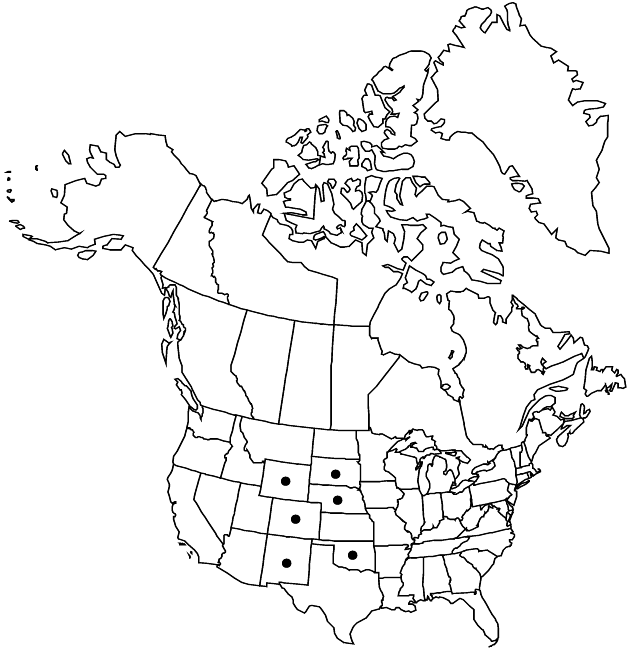Difference between revisions of "Solidago speciosa subsp. pallida"
Sida 20: 1615. 2003.
FNA>Volume Importer |
FNA>Volume Importer |
||
| Line 29: | Line 29: | ||
|elevation=1300–1500+ m | |elevation=1300–1500+ m | ||
|distribution=Colo.;Nebr.;N.Mex.;Okla.;S.Dak.;Wyo. | |distribution=Colo.;Nebr.;N.Mex.;Okla.;S.Dak.;Wyo. | ||
| − | |discussion=<p>Subspecies pallida is an eastern woodland-prairie relict (W. A. Weber 1990), occurring in the Black Hills of South Dakota and adjacent Wyoming, the eastern foothills of the Colorado Front Range, and in a few scattered locations southeast to the New Mexico–Oklahoma border area. It is usually much shorter (20–80 cm) than is typical for the species, the array representing about half the height of the shoot. The leaves are much less crowded than those of var. rigidiuscula. A few plants similar in appearance to subsp. pallida, but taller, have been seen in the Carolinas and Tennessee; they belong in var. speciosa.</p> | + | |discussion=<p>Subspecies pallida is an eastern woodland-prairie relict (W. A. Weber 1990), occurring in the Black Hills of South Dakota and adjacent Wyoming, the eastern foothills of the Colorado Front Range, and in a few scattered locations southeast to the New Mexico–Oklahoma border area. It is usually much shorter (20–80 cm) than is typical for the species, the array representing about half the height of the shoot. The leaves are much less crowded than those of <i></i>var.<i> rigidiuscula</i>. A few plants similar in appearance to <i></i>subsp.<i> pallida</i>, but taller, have been seen in the Carolinas and Tennessee; they belong in <i></i>var.<i> speciosa</i>.</p> |
|tables= | |tables= | ||
|references= | |references= | ||
| Line 53: | Line 53: | ||
|publication year=2003 | |publication year=2003 | ||
|special status= | |special status= | ||
| − | |source xml=https://jpend@bitbucket.org/aafc-mbb/fna-data-curation.git/src/ | + | |source xml=https://jpend@bitbucket.org/aafc-mbb/fna-data-curation.git/src/8f726806613d60c220dc4493de13607dd3150896/coarse_grained_fna_xml/V19-20-21/V20_249.xml |
|tribe=Asteraceae tribe Astereae | |tribe=Asteraceae tribe Astereae | ||
|genus=Solidago | |genus=Solidago | ||
Revision as of 16:21, 18 September 2019
Plants 30–80 cm. Leaves: pale green, somewhat glaucous, basal usually persistent at flowering, 5–50 mm wide, entire or serrulate (1-5 teeth per side distally); mid cauline 7–28 mm wide, not crowded, not stiff, glabrous. 2n = 18.
Phenology: Flowering Sep.
Habitat: Prairies and pine forests, sandy soils
Elevation: 1300–1500+ m
Distribution

Colo., Nebr., N.Mex., Okla., S.Dak., Wyo.
Discussion
Subspecies pallida is an eastern woodland-prairie relict (W. A. Weber 1990), occurring in the Black Hills of South Dakota and adjacent Wyoming, the eastern foothills of the Colorado Front Range, and in a few scattered locations southeast to the New Mexico–Oklahoma border area. It is usually much shorter (20–80 cm) than is typical for the species, the array representing about half the height of the shoot. The leaves are much less crowded than those of var. rigidiuscula. A few plants similar in appearance to subsp. pallida, but taller, have been seen in the Carolinas and Tennessee; they belong in var. speciosa.
Selected References
None.